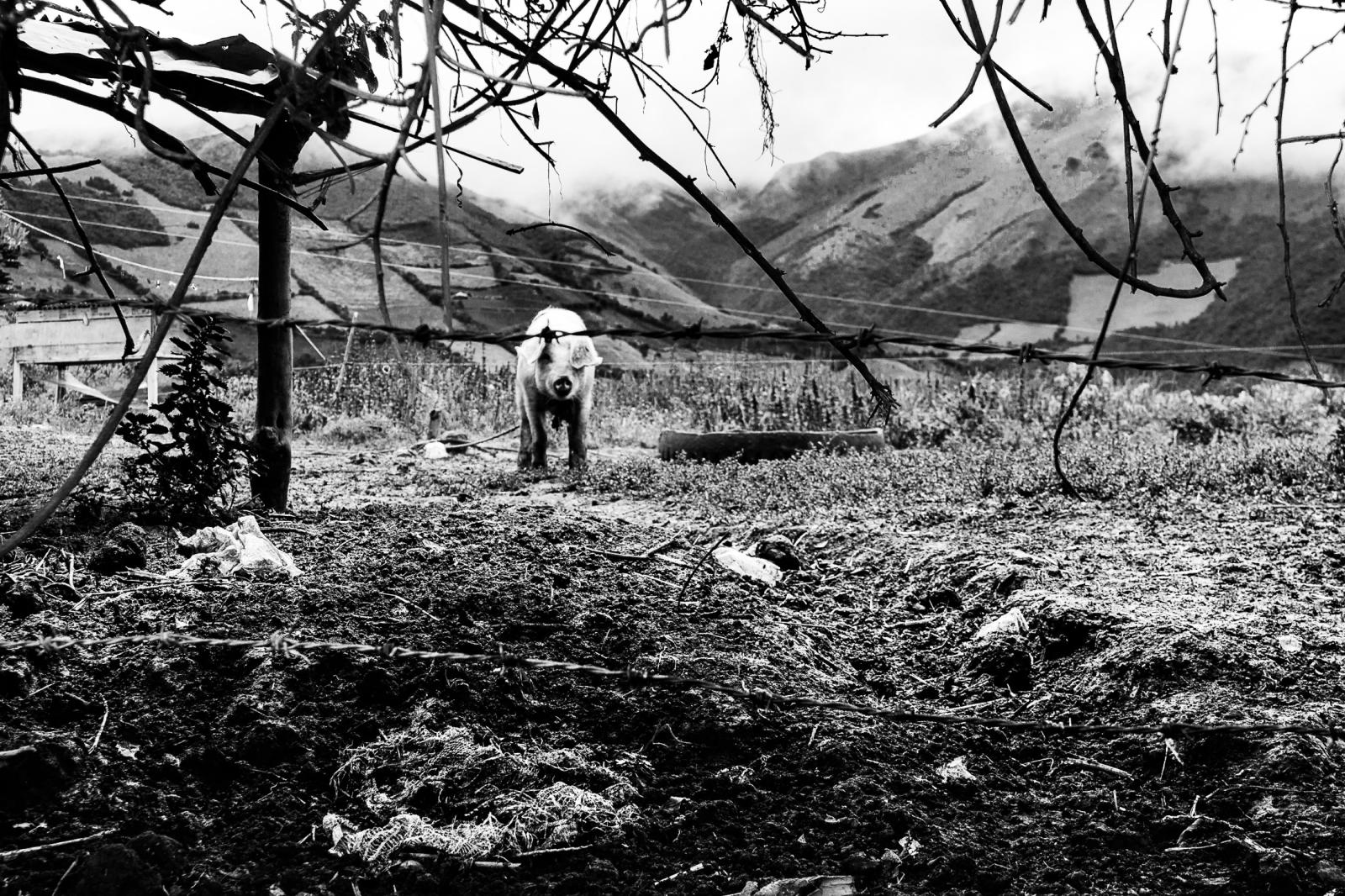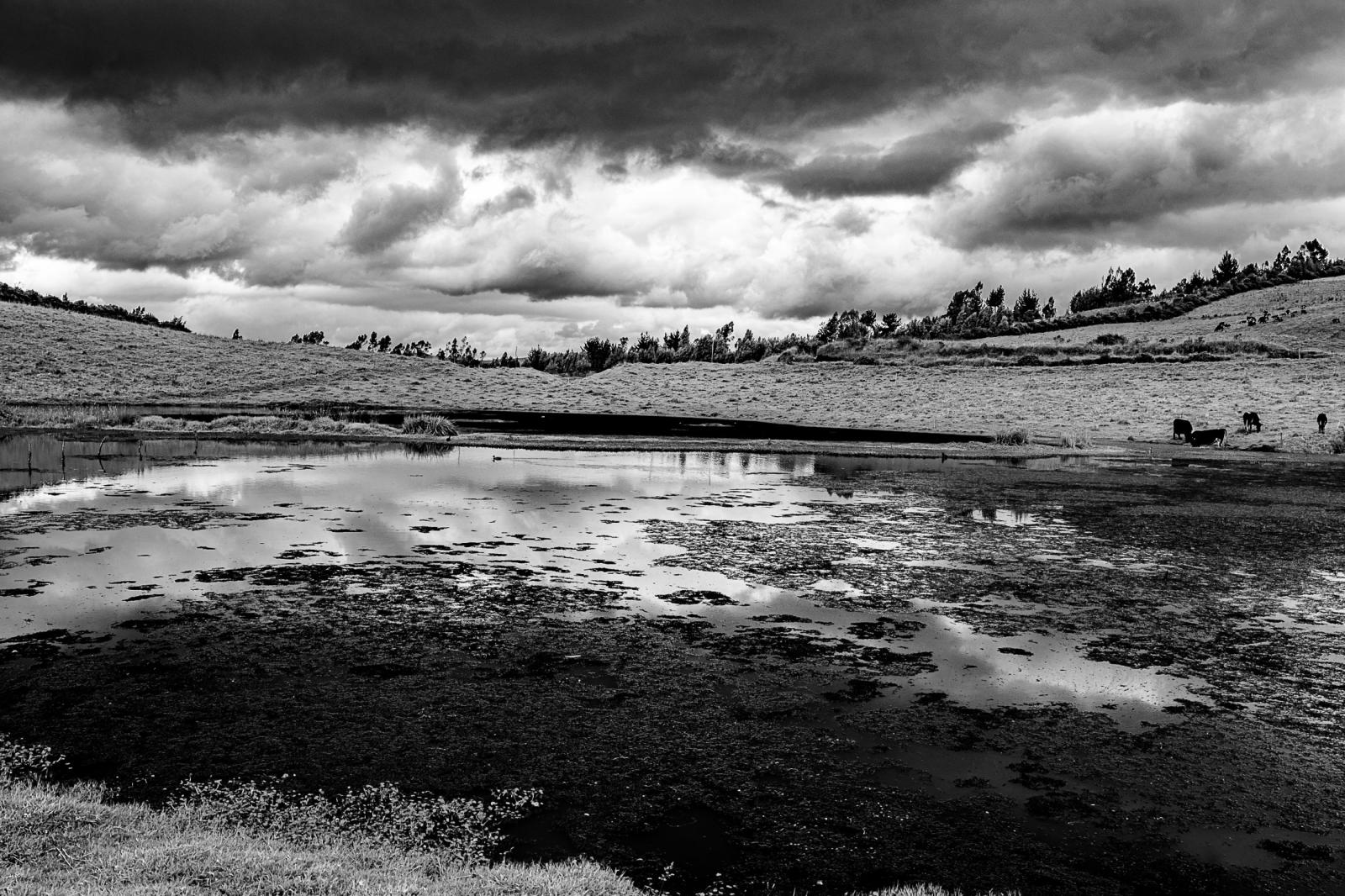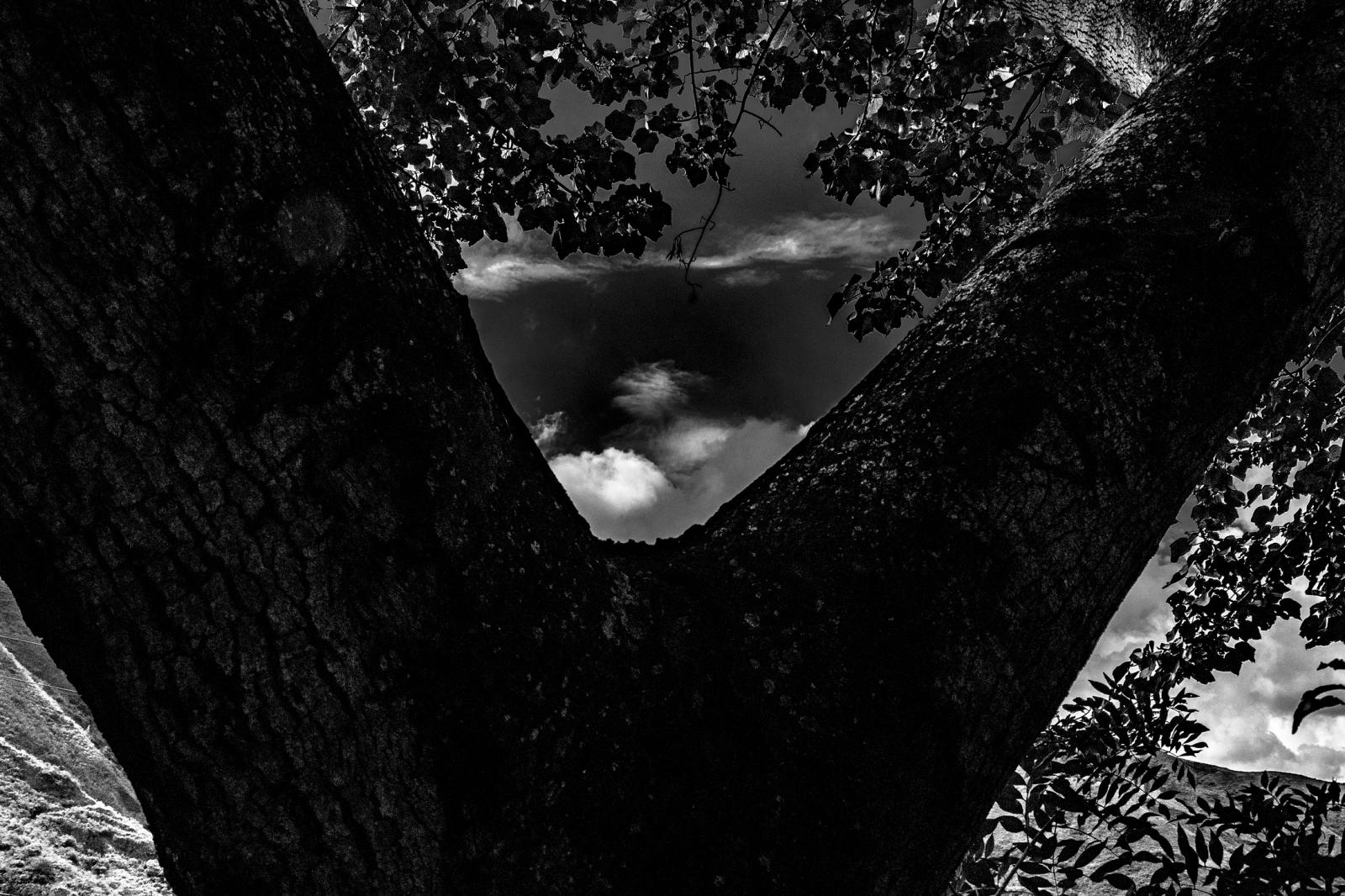Nariño is a Colombian region bordering with Ecuador and with exit to the Pacific Ocean. 9,000 coca cultivated areas (the second largest production nationwide, Colombia being the main producer in the world) and 31,816 displaced people in 2021 by control disputes of illegal economies in hard to reach zones, ignite a conflict that pays down the higher figures of sexual violence victims. In light of the above, a series of photographs based on reports of sexual offenses arises, where the body is not the support but rather confrontation/testimonial/image, shaping other anatomies into the landscape.
In the defiled womb of furrows
there are scents of fresh rebelliousness.
Alberto Quijano Guerrero
I read from the master Eusebio Calonge that «Art does not deliver us from suffering, neither it averts injustices, but it takes the last say away from the torturers». With that sentence, I began a journey outwards, without a backward glance so I would not be under the risk of becoming petrified, but with the opening of the eyes that has been the chink to multiply myself even if it is in an ephemeral way. Sitting in a criminal court’s office in front of a stream of sexual offenses’ prosecutions, I thought of the words of the poet Paul Éluard regarding poetry and how it arises when outer circumstances concur with the circumstances of the heart. «In that conversation where the fragilities come together and mutually confess», I found out that it was not too late yet. Testimonial photographs emerged from 24 municipalities of the Colombian south, Nariño, on which sexual violence is a flag that flutters in all the landscapes, in the midst of the forced recruitment, the trafficking of women and children in exchange for ammunition, the sexual exploitation of immigrants, the massacres, the dispute of lands for the control of illegal economies, drug trade routes and terrestrial and maritime border-crossings causing displacement of indigenous and afro-Colombian peoples and peasants, the murder of communal, social and environmental leaders, entire regions sprayed with glyphosate, and mining and energy projects that poison networks of rivers and creeks. From examining the landscape, images came about that revealed signs in flesh, in living soil. This crossing between history and the violent craft of seeing reminded me of these words: «With those photos you will not make the revolution». I go out and shoot.
Facing a blue contour of cordilleras, the old houses stand in colors, centuries and terrors, many others rise, red and grey of blood and weariness. The moss archives shrouds, the shadow of the old roof languishes and, with no light for the silence, the farm labourers turn melancholic, the bees do not buzz. In mouths without voice the sobs of inconsolable children ripen, they grow alone like trees weathering the violence, with no cradles, no nursemaids, under the caress of the winds and the grassland, along with the tenderness of birds, dogs, cats, cows, horses. The inner armed conflict is far from reaching an end, after the signing of the peace agreements with the extinct Fuerzas Armadas Revolucionarias de Colombia FARC (Armed Revolutionary Forces of Colombia) in 2016; the genocide democracy in Colombia continues to create fictional battle fields and exhibiting battle casualties: 11, 39, 75, 45, 154, 5763, 6402, figures, because, in any of the systems, victmizers only fight over the higher status of terror. A throng of trunks lie decapitated, darkened suns.
Fernando Pessoa wrote «There are sensations felt just by imagining them that are more ours that the very life». Music breaks, I am hurt, memories of horror from the terror inscribed in the bodies go through me, language is depleted, it comes short when I think that around the rubble nothing can be done, screams burst, screaming of so much quieting, the horizon of forthcoming rebellions, premonition of future storms. I do not try to judge human penuries, not by any means to divulge or translate grim and sullen images as one who describes something without getting involved in any form; I seek to lodge an idea that does not turn out irreducible to itself, that is a circuit-breaker, resistance to communication —which is limited to transmitting information and, on many occasions, just keeping or propagating a control system—, believing in the effects of what befalls and mutates in order to be excavated. Return. Irene Vallejo and her word, «It is not enough to become enraged against injustice: it is necessary to protect those who unmask it». Everything is at war here. The human clangor hushes and the deceased landscape dreams of life gazing at its grave.
Nariño es un departamento colombiano fronterizo con Ecuador y con salida al pacífico. 9.000 áreas sembradas de coca (el segundo departamento con la más alta producción a nivel nacional, siendo Colombia el mayor productor en el mundo) y 31.816 desplazados durante 2021 por el control de economías ilegales en zonas de difícil acceso, avivan un conflicto que tributa las cifras más altas de violencia sexual en Colombia. De lo anterior surge una serie fotográfica basada en denuncias penales sobre delitos sexuales en las que el cuerpo no es sostén sino confrontación/testimonio/imagen, configurando anatomías otras en el paisaje. Una investigación exploratoria que no conduce a la constatación de hechos sino a los hallazgos que surgen en los lugares de los hechos y busca hospedar a quienes con coraje funden su voz, «Para que el sufrimiento de cualquiera se haga peste colectiva».
En la matriz violada de los surcos
hay olores de frescas rebeldías.
Alberto Quijano Guerrero
Leí del maestro Eusebio Calonge que «El arte no nos libera del sufrimiento y tampoco evita las injusticias, pero le quita la última palabra a los verdugos». Con esa sentencia comencé un viaje hacia el afuera, sin volver la mirada atrás para no correr el riesgo de petrificarme, mas con la apertura de los ojos que ha sido el resquicio para multiplicarme así sea de manera efímera. Sentada en un juzgado frente a un caudal de procesos sobre delitos sexuales pensé en las palabras del poeta Paul Éluard sobre los poemas y cómo surgen cuando las circunstancias del exterior coinciden con las circunstancias del corazón. «En esa conversación en la que las fragilidades se juntan y se confiesan mutuamente», descubrí que todavía no era demasiado tarde. Surgieron fotografías testimoniales de 24 municipios del Sur de Colombia, Nariño, en las que la violencia sexual es una bandera que se ondea en todos los paisajes; en medio del reclutamiento forzado, del intercambio de mujeres, niñas y niños por municiones, de la explotación sexual de migrantes, de masacres, de la disputa de tierras por el control de economías ilegales, rutas de tráfico y pasos fronterizos terrestres y marítimos causantes del desplazamiento de pueblos indígenas, afro-colombianos, campesinos, asesinatos a líderes comunales, sociales y ambientales, regiones enteras asperjadas con glifosato, y proyectos minero energéticos que envenenan redes de ríos y quebradas. De interrogar al paisaje acontecieron imágenes que revelaron signos en carne, en tierra viva. Ese cruce entre la historia y el violento oficio de mirar me recordó estas palabras: «Con esas fotos no harás la revolución». Salgo y disparo.
Frente a un perfil azul de cordilleras, las viejas casas se yerguen de colores, siglos y espantos, se levantan otras tantas, rojas y grises de sangre y cansancio. El musgo archiva sudarios, languidece la sombra de la vieja techumbre y, sin luz para el silencio, los labriegos se tornan melancólicos, las abejas no zumban. En bocas sin voz maduran los sollozos de inconsolables niños, crecen solos como árboles resistiendo los embates de la violencia; sin cunas, sin ayas, a la caricia de los vientos y el llano, junto a la ternura de los pájaros, los perros, los gatos, las vacas, los caballos. El conflicto armado interno está lejos de terminar, después de firmado el acuerdo de paz con las extintas Fuerzas Armadas Revolucionarias de Colombia FARC en 2016, la democracia genocida en Colombia sigue creando campos de batalla ficticios y exhibiendo bajas en combate: 11, 39, 75, 45, 154, 5763, 6402, cifras, porque en cualquiera de los sistemas los victimarios sólo se disputan el mayor estatus del terror. Multitud de troncos yacen decapitados, oscurecidos soles.
Escribió Fernando Pessoa que «Hay sensaciones sentidas sólo con imaginarlas que son más nuestras que la propia vida». La música se quiebra, estoy herida, los recuerdos del horror del terror inscrito en los cuerpos me atraviesan, el lenguaje se agota, no alcanza y cuando pienso que alrededor de los escombros nada puede hacerse, estallan gritos que gritan de tanto callar, horizonte de próximas rebeldías, premonición de futuras tempestades. No pretendo enjuiciar penurias humanas, menos divulgar o traducir imágenes hoscas y sombrías como quien describe algo sin involucrarse de ninguna manera, busco hospedar una idea que no resulte irreductible a ésta, que sea interruptor, resistencia a la comunicación —que se limita a transmitir información y, en muchas ocasiones, sólo a mantener y propagar un sistema de control—, creyendo en los efectos de lo que acontece y muta para ser excavado. Retorno. Irene Vallejo y su palabra: «No basta enfurecerse contra la injusticia: es necesario proteger a quien la desenmascara». Aquí está todo en guerra. Calla el humano estrépito y el paisaje difunto sueña con la vida contemplando su tumba.































